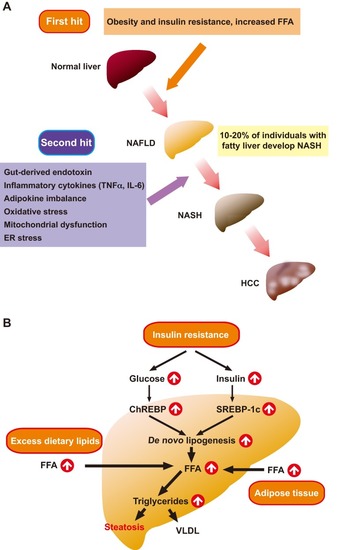
Mechanisms of NASH: the two-hit model. (A) In the two-hit hypothesis of liver disease development, steatosis (fatty liver causing NAFLD) represents the ‘first hit’ that sensitizes the liver to injury mediated by ‘second hits’, such as from endotoxin, inflammatory cytokines, adipokines, oxidative stress, mitochondrial dysfunction and/or ER stress. Receipt of both hits leads to the steatohepatitis and fibrosis of NASH, and eventually the development of hepatocellular carcinoma. (B) Obesity and insulin resistance lead to an increased release of FFA from adipose tissues and enhanced FFA flux to the liver. In the liver, hyperinsulinemia induces SREBP-1c expression, which increases de novo lipogenesis via activation of lipogenic gene transcription. At the same time, hyperglycemia activates ChREBP, which also activates the transcription of lipogenic genes, increasing de novo lipogenesis and FFA levels. These fatty acids can either be oxidized in the mitochondria to generate ATP, or esterified to produce triglycerides. These triglycerides are either incorporated into VLDL for export from hepatocytes, or are stored within hepatocytes, leading to steatosis.
|